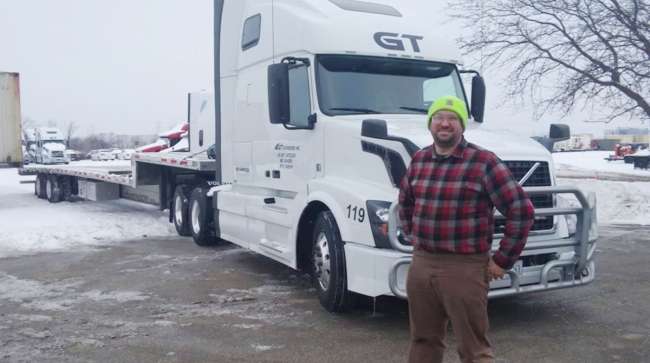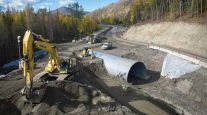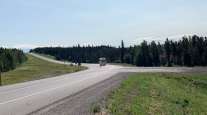Staff Reporter
Trucker Turned Politician Proposes Bill Honoring Alaska’s Drivers

[Stay on top of transportation news: Get TTNews in your inbox.]
An Alaskan state senator and professional driver is sponsoring Truck Driver Appreciation Day legislation to permanently recognize truckers for their service.
Robert Myers Jr. (R) is championing Senate Bill 150, for the second Monday of every September to be Truck Driver Appreciation Day. It would coincide with American Trucking Associations’ National Truck Driver Appreciation Week, a celebration that typically is marked by events and driver recognition from individual fleets.
Myers’ idea for the law occurred last September, when truckers are shown appreciation in Alaska with free donuts at weigh stations or barbecues that many cannot attend due to driving. At that time, Alaskans sent Myers photos of empty store shelves due to supply chain issues. His district includes the city of North Pole and North Fairbanks.
Who Supports the Bill?
Truck Driver Appreciation Day has bipartisan support from half of Alaska’s senate. Co-sponsors are:
Republicans — Mia Costello, Roger Holland, Shelley Hughes, Peter Micciche, Lora Reinbold, Mike Shower and Gary Stevens
Democrats — Elvi Gray-Jackson, Scott Kawasaki and Jesse Kiehl
Alaska Trucking Association Executive Director Joe Michel said the legislation is an easy bill to pass “in these contentious times.” He testified Feb. 15 in support of the legislation along with Philip Whitlatch, an association board member and linehaul driver supervisor for Crowley Fuels.
“When you have an accident out on a lonely stretch of highway,” Whitlatch said, “of course, you’re looking for the police and fire department to show up, but usually a lot of times the first people that are going to be on scene are going to be truck drivers to help you out and help you deal with the entire shock of an incident on our highway system.”
Although truckers can be seen on roads, Myers said they don’t have high-profile public interactions and are “unsung heroes” happy to provide a vital public service. Their service has been demonstrated during the pandemic.
Myers noted that Alaska has experienced acute ongoing supply chain shortages, evidenced by empty shelves in December and January due to bad weather in British Columbia that made truck travel difficult.

Alaska truckers transport goods ranging from fresh produce to equipment for the oil and mining industries. (Office of Sen. Robert Myers)
“Driver shortages are causing more strain upon our truck drivers,” he said. “We want to show appreciation they more than deserve. They are quite literally driving the Alaskan economy.”
Myers said 95% of the general freight brought into Alaska is transported on barges, but trucks bring goods ranging from fresh to equipment for the oil and mining industries.
Unless they’re driving to “the Lower 48” through British Columbia, Alaskan drivers usually are two or three days away from home — not several days or weeks compared with drivers in other states, Myers said.
However, Alaskan truck drivers routinely face extreme weather, mostly drive on gravel roads, can travel for 100 miles with tire chains and dodge animals not cars.
Michel praised Myers as “a good ambassador for the trucking industry” and a “humble dude” who beat a longtime incumbent. In 2020, Myers won by 14 votes against John Coghill Jr., who served 12 years in the state Senate and 10 years in the House.
Michel also expressed high esteem for Myers’ truck driving skills on the dangerous, mostly gravel Dalton Highway (Haul Road) to the Arctic Ocean. Advised to bring survival gear and propane tanks, truckers driving that isolated 414-mile road must watch out for moose and herds of caribou and musk ox.
The Haul Road
The Haul Road, technically Alaska Route 11 or the James W. Dalton Highway, was built in 1974 as a supply route for the trans-Alaska pipeline and the Prudhoe Bay oil fields. It starts in Livengood, about 80 miles north of Fairbanks, and runs 414 miles to Deadhorse near the Arctic Ocean. Only a quarter of the road has a hardtop. The other 75% is gravel.
Source: University of Alaska — Museum of the North
Myers said he has hit four moose, each weighing over 1,000 pounds, and once destroyed his radiator in the process.
He frequently drives the Haul Road, where his cellphone is out of range for 11 hours and there are only two gas stations. He said he earns from $1,000 to $1,400 for 2½ days’ work driving the Haul Road bringing equipment to the Alaska pipeline at Prudhoe Bay.
He brings a full set of tools, extra food and water and winter gear, including insulated overalls. It’s the treacherous winter weather and storms there that concern his wife, not the summer temperatures of 50 to 60 degrees. If his truck breaks down during the winter, he must wait inside for several hours because he could freeze to death outside in 50-below temperatures that could feel like 90 below due to wind chill.
His career as a professional driver began in college when he worked four months per year on a tour bus. After his education, Myers, who is from Fairbanks, needed steady employment and turned to driving trucks. He is father to five children ages 2 to 9.
He said the best part of driving a truck is experiencing Alaska’s varied scenery and wildlife. As a senator, he has to switch between careers that have almost nothing in common.
“Trucking involves physical activity. I often don’t talk to anyone, just me and the audio books,” he said. “In the Legislature, there are a lot of interruptions and talking. There is less mobility and it’s emotionally demanding.”
Want more news? Listen to today's daily briefing below or go here for more info:




